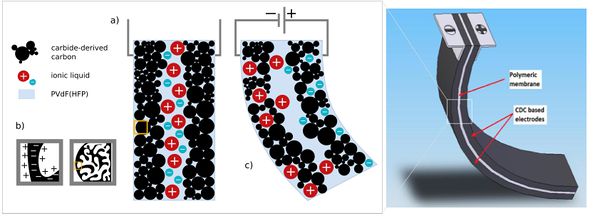Mediawiki/index.php/EAPedia
Carbide-derived Carbon-based Actuators
Non-faradaic charge storage mechanism, where chemisorbed ions reside on porous electrode to form an electrochemical double-layer (EDL) holds a great potential not only in EDL capacitor applications, but also actuator applications. Carbide-derived carbon (CDC), also known as tunable nanoporous carbon, is the common term for carbon materials derived from carbide precursors (e.g. SiC, TiC). When the porous carbon-based electrode is immersed into an electrolyte solution (i) or electrolyte is introduced into the porous carbon material (ii), charge is accumulated at the interface due to the presence of mobile electronic and ionic charge carriers. As seen in Fig. 1 the design of ionic polymer actuators is comparable to electrical double-layer capacitors, often referred as supercapacitors or ultracapacitors. Supercapacitors are highly capacitive devices famous for their high power densities and remarkable energy conversion efficiency up to 98% during the charging-discharging cycle.
Electrochemical origin of porous carbon-based actuators
Charge induced electromechanical actuation is a combination of charge injection during electrical double-layer charging of high surface area carbon, and ion migration/accumulation induced by charge distribution. Both effects result in the more expressed expansion of the negatively polarized electrode (cations accumulation) compared to the positively polarized electrode (anions accumulation). This makes possible to construct three-layered bending device, similar to CNT actuators and other carbon-based actuators. By its nature, the three-layered CDC-based bending device has two features when voltage is applied. Firstly, it is a bending-type electrochemical actuator with reversible actuation properties in volage range between -2.5 V and +2.5 V. Besides the external shape-changig properties, this device is also an electrochemical capacitor, providing opportunity to store a considerable amount of charge. The design of CDC-based flexible, three-layer actuator is comparable to electrochemical capacitors. The working mechanism is similar, as well as driving voltage (below 3.5 V). However, components of supercapacitors are mounted into hermetically sealed cell to provide high power-densities, long lifetimes, and remarkable energy conversion efficiency.
Actuator preparation
The bending actuator device for open-air applications was obtained by hot-pressing CDC-based electrodes (PVdF was used as binder) and IL containing polymer membrane (PVdF) was sandwiched between two electrode layers. One of the advantages of the CDC-based three-layered composite as an actuator material is that it can be easily formed into various shapes, its properties can be engineered and it can potentially be integrated with MEMS, sensors and control devices to produce smart systems. Forming the self-standing separator layer and electrode layers can be easily made by casting the dispersing solution and evaporating the solvent completely. This simple route offers sufficient control over the thickness of resulting CDC layer. CDC synthesized from titanium carbide (TiC) is widely used electrode material for actuator applications. Following is the example for preparation of reliable actuator based on TiC-800 CDC (TiC is chlorinated at 800 °C)
